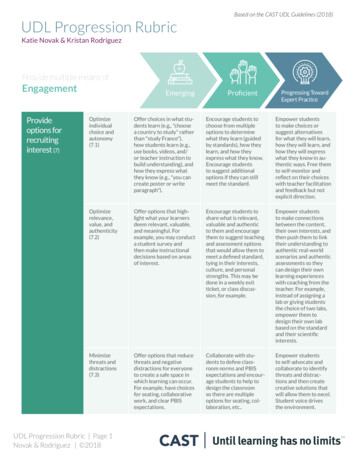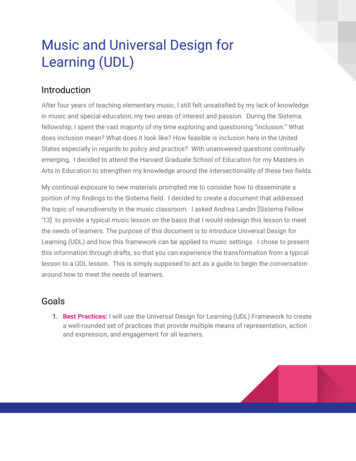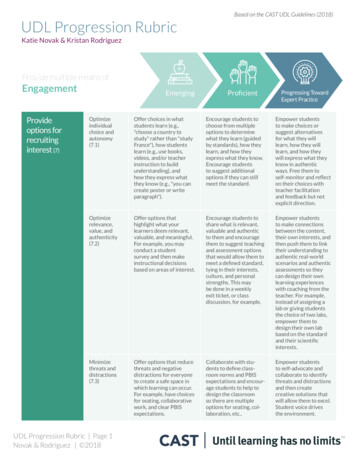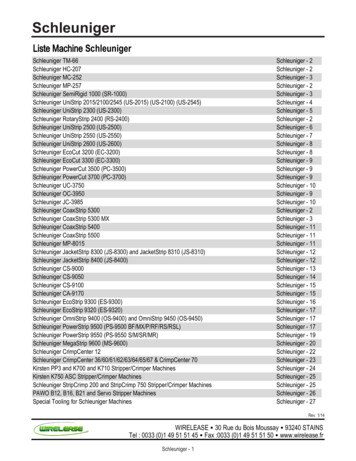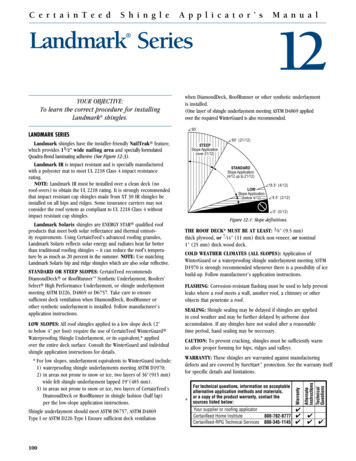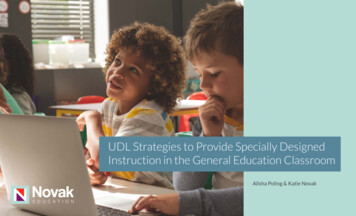
Transcription
UDL Strategies to Provide Specially DesignedInstruction in the General Education ClassroomAlisha Poling & Katie NovakE D U C A T I O N
Supports/Services FlowchartGeneralEducationLearningStandardAre there barriers tostudent’s learning?Yes. Does studenthave an IEP?Yes. Student has an IEP.Decide HOW the informationwill be taught (what will SDIlook like)ContentWill assignments bemodified?MethodologyNoNeeds can be metthrough UDL andbest teachingpracticesNo. But student hasbarriers in reading/language or a 504planNeeds can be metthrough UDL,best teachingpractices, andaccommodations.Apply UDL,accommodations asoutlined in IEP, and SDIEnsure supports are inplace so that studentis accessing thelearning taking placein the classroom whilesimultaneously workingon IEP goals.Decided WHAT and WHY tobe taught by consulting withIEP Team.SDIWhat unique teachingstrategies work best forthe student?Delivery ofInstructionWhat strategy will beused to address specificstudent need?Accommodations (SeeIEP)Page 2
Continuum of Supports/Services for StudentsUniversal Supports for All StudentsAcademic Visual aids Sentence starters Text-to-speech/audiobooks(for assignments) Graphic organizers Variety of pens/pencils (color,size, tactile feedback, etc) Adaptive pen/pencils Adaptive paper (raised line,highlighted lines, etc). Slant board Personal dry erase marker Non-slip writing surface Pre-written words/sentences/phrases Writing templates, notes,outlines Pocket dictionary/thesaurus Word wall, word books, wordcards Sentence starters Story starters Framed paragraphs Change size of text Change spacing, text color,background/contrast Picture symbols with text Book holders Predictable books Color overlays Tracking strategies (readingwindow, bar magnifier) Number lines ManipulativesAdditional Accommodations(usually require 504 plan or IEP, but not in allstates - check your state guidelines) Abacus Multiplication table (forassignments) Math facts charts Worksheets with enlargedspaces for responses Modified paper (grid paper,raised lines, bold lines) Chunking directions Visual cues Highlighted text Checklists Recording devices (both audioand video) Pre-recorded videos Speech generating device (forassignments) Communication board Communication books Core board Timers Digital documents Note-taking devices Calculator (for tests)ScribeMultiplication table (for tests)“Key words” notecard (for mathproblem solving)Text-to-speech/audiobooks (for test)Speech-to-text (for tests)Speech generating devicePersonal visual scheduleCustomized checklistsPersonal electronic device (computer,smart phone, apps, tablets)Communication system (such as PECS)Note-taking devices (Braille writer)Specialized software for wordprediction, text reading, textenlargement, communication, Brailletranslation)Personal amplification systemSpecialized flexible seating optionsSDI (can be provided via push-in by interventionist,EL, or SPED or by the gen ed teacher) Small group instruction (using districtapproved curriculum) during centers/grouptime to target deficits Scaffold work for individual students andprovide explicit instruction and/or step-bystep instructions on how to complete work(in reading, writing, and math) Re-teach subject matter using a differentmethodology For reading tests: pull kids into small groupand scaffold questions for students basedon their needs Provide direct (additional) teaching to helpstudent organize their thoughts/ideas/responses based on their IEP goals Provide direct instruction on how todecode words (using a district approvedcurriculum) based on IEP goals Use of district approved computerprograms that have adaptive learningcapabilities Modifying content and providing materialsbased on IEP goalsData Collection Methods(to measure AYP, drive instruction, and allowstudents to demonstrate what they know) DrawingsVideo recordingsWorksheetsTestsWritten workPrinted workData sheetsAudio recordingsSocial/Behavioral Elimination of extraneousnoise (air vents, etc.) Visual schedules Color coding Systems for organization(binders with dividers, pocketfolders) Checklists Wiggle seats Therabands Access to break spacePage 3
UDL Strategies to Provide Specially Designed Instruction in the General Education ClassroomReadingActivity (What?)Barrier(s)Continuum of Universal ToolsAvailable for All Students (*indicates Accommodations thatdemand an IEP/504) (How?)SDI Options (content, methodology, and/or delivery of embedded/explicit instruction) (How?)Adapting ContentIndependentlyreadingtext and/oransweringcomprehensionquestions Additional supportneeded to accesstext Limited amount ofleveled/adaptedmaterials Lack of scaffoldsto aid withcomprehension Additional time/instructionneeded to improvereading skills Flexible seating Change spacing, text color,background/contrast Offer tracking strategies(reading window, barmagnifier, book holder) Use of visual aids, gestures,graphic organizers tounderstand connectionsbetween events/information Predictable texts Text read aloud via peermodel Text read aloud by teacher Text read aloud by usingtext-to-speech embeddedsupport tool* Text read aloud by usingspecialized apps* Picture symbols with text* Modified books/readingmaterials Modifying tests (changingthe learning target/standard)Adapting MethodologyAdapting Instruction Read-spell-read Choral reading Listening to text readaloud and followingalong with finger Embedded Instruction: Look for naturallyoccurring opportunitiesto target decoding skills,comprehension skills, and/orscaffold instruction (createaccess point)Visual LearningExplicit Instruction Highlighting text as it’sbeing read Visual aids/models forkey terms Graphic organizers/scaffolds for answeringcomprehensionquestions and/orimproving word attackskills Pull small group duringindependent work time/centers and re-teachdecoding skills using districtapproved curriculum for atleast 20 minutes to targetdeficits Work with individualstudents who needadditional support decodinggrade level words Provide 10-15 minutesexplicit instruction on howto decode multisyllabicwords During independent worktime/centers using a districtapproved, adaptive reading(computer) programAuditory LearningKinesthetic Learning Dancing while reading/decoding Counting syllables usingmanipulatives Using arm strategy orother physical prompt toblend/segment words* Indicates Accommodations that often demand an IEP/504. Check your specific state guidelines to determine if this applies.Assessments and Assessments Options with Scaffolding (Artifact?)Fluency Assessments (Timed) Remove time constraint Mask material to prevent distractions Additional visual/verbal promptingStandard/Traditional Comprehension Assessments(paper/pencil tests) Sentence startersFramed paragraphsStudent notecard with key termsEliminate choicesAdditional visual/verbal promptsAlternative Assessments Allow students to draw a picture of the story orcreate an artwork depicting major components ofthe text Create video of students retelling events/describing key details of text Audio recording of students answeringcomprehension questions and/or explaining keyideas of textPage 4
Activity (What?)IntroducingVocabulary WordsContinuum of Universal ToolsAvailable for All Students ()(How?)SDI Options (content, methodology, and/or delivery of embedded/explicit instruction) (How?)Assessments and Assessments Options with Scaffolding (Artifact?)Barrier(s) Additional supportneeded to accesstext Limited texts/waysto present newvocabulary Lack of opportunitiesto model correctpronunciation/articulation Vocabulary termsonly presented inEnglish (missedopportunity toactivate priorknowledge in nativelanguage) Flexible seating Change spacing, text color,background/contrast Offer tracking strategies(reading window, barmagnifier, book holder) Use of visual aids, gestures,graphic organizers tounderstand connectionsbetween words and theirmeanings Use of chunking informationand/or pneumonic devicesto aid with comprehension/retention Completing vocabularyactivities with peer model Interactive (digital)vocabulary cards Words read/communicatedby using specialized apps* Picture symbols with text(communication boards)* Where possible, usesynonyms that provide otherword options.Adapting ContentAdapting MethodologyAdapting Instruction Modified books/readingmaterials Modifying tests (changingthe learning target/standard) Modifying vocabulary words(learning easier concepts)Auditory LearningEmbedded Instruction Read-spell-read Choral reading Listening to text readaloud and following alongwith finger Songs to remember newwords/terms Look for naturally occurringopportunities to targetdecoding skills, comprehensionskills, and/or scaffoldinstruction (create accesspoint)Visual Learning Highlighting text as it’sbeing read Multiple visuals depictingvarious word meanings Graphic organizers/scaffolds for acquiring newlanguage Combining pictures withtextKinesthetic LearningStandard/Traditional Vocabulary Test (worksheet orother written test) Fill in the blankWord banksGraphic organizerEliminate choicesAdditional visual/verbal promptsExplicit InstructionAlternative Assessments Pull small group duringindependent work time/centers and re-teachvocabulary using districtapproved curriculum Work with individual studentswho need additional supportlearning new terms Using a district approved,adaptive computer programto target language/readingdeficits Allow students to draw a picture/make a model thatdemonstrates comprehension of word Create video of student describing word meaning/acting out word meaning Audio recording of student completing worksheet ordescribing word meanings Dancing while reading/decoding Drawing pictures of words Using gestures to learnnew words/concepts* Indicates Accommodations that often demand an IEP/504. Check your specific state guidelines to determine if this applies.Page 5
WritingActivity (What?)Barrier(s)Continuum of Universal ToolsAvailable for All Students (*indicates Accommodations thatdemand an IEP/504) (How?)SDI Options (content, methodology, and/or delivery of embedded/explicit instruction) (How?)Adapting ContentWriting(ProducingContent) Additionalspelling/grammarsupport needed Additionalvisual supportneeded to aid incomprehension,generate ideas,and organizeinformation Limited ways togather informationfor research Lack of studentexamples asguides/models Additional time/instruction neededto teach grammar,sentence building,generatingideas, organizingsentences, etc. Limited choiceson how to productartifact/content Only allowingstudents to handwrite information Flexible seatingSentence startersFramed paragraphGraphic organizers/flowchartsNote cardsChecklistsVisual models/examplesSpellcheck/dictionaryAdaptive paper/pencils*Word prediction software*Speech-to-text*Scribe* Modified writingassignment (shortened,simplified assignment) Modified grading rubricAdapting MethodologyAssessments and Assessments Options with Scaffolding (Artifact?)Adapting InstructionAuditory LearningEmbedded InstructionStandard/Traditional Writing Assessments Pneumonic devices/songs for spelling/grammar rules Speaking the contentprior to writing it Student reads workaloud while editing Look for naturally occurringopportunities to targetencoding skills, grammarskills, organization skills, and“thinking out loud” (metacognition). Students complete writing assignment using UDLtools, accommodations, and/or modifications.Visual Learning Drawing pictures priorto writing Completing graphicorganizers Looking at pictures forcontext during writingprocess Think-draw-write Aligning tasks to avisual model (OREO,hamburger paragraphwriting, RAPP)Kinesthetic LearningExplicit Instruction Pull small group duringindependent work time/centers and re-teachgrammar/spelling/writingskills Work with individualstudents who needadditional support withwriting Use a district approvedcomputer program toprovide word ve Assessments Allow students to use a word bank to createsentences Allow students to organize pre-written sentencesin order to build a paragraph Allow students to draw a picture/make artworkand orally explain how it meets the learning target Create video of student acting out “writing”content and explaining how they’ve met thelearning target Audio recording of student explaining theirthinking (writing) and explaining how it meets thelearning target Allow students to use a communication device to“speak” what they want to write Allow students to use a scribe to communicatetheir thoughts Dancing/walking/moving during thewriting process* Indicates Accommodations that often demand an IEP/504. Check your specific state guidelines to determine if this applies.Page 6
Activity (What?)Barrier(s)Continuum of Universal ToolsAvailable for All Students (*indicates Accommodations thatdemand an IEP/504) (How?)SDI Options (content, methodology, and/or delivery of embedded/explicit instruction) (How?)Adapting ContentWriting(Handwriting) Limited choice oftools to developfine motor skills Lack of preferredwriting tools(ie. variety) tomotivate andencourageparticipation Lack of studentexamples asguides/models Only certain typesof paper deemed“acceptable”for assignments(adaptive papernot provided) Few visual aids oropportunities tomodel skills Additionalspelling/grammarsupport needed Flexible seatingChecklistsSlant boardHighlighting/tracing guidesVisual modelsVariety of writing utensilsPencil gripsGraphic organizersAdaptive paper/pencils* Modified writingassignment (shortened,simplified assignment) Modified grading rubricAdapting MethodologyAssessments and Assessments Options with Scaffolding (Artifact?)Adapting InstructionAuditory LearningEmbedded InstructionStandard/Traditional Writing Assessments Pneumonic devices/songs for spelling/grammar rules Speaking the contentprior to writing it Student reads workaloud while editing Look for naturally occurringopportunities to targetencoding skills, grammarskills, organization skills,and “thinking out loud”(metacognition). Students complete writing assignment using UDLtools, accommodations, and/or modifications.Visual Learning Drawing pictures priorto writing Completing graphicorganizers Looking at pictures forcontext during writingprocess Think-draw-write Aligning tasks to avisual model (OREO,hamburger paragraphwriting, RAPP)Kinesthetic LearningExplicit Instruction Pull small group duringindependent work time/centers and re-teachgrammar/spelling/writingskills Work with individualstudents who needadditional support withwriting Use a district approvedcomputer program toprovide word ve Assessments Allow students to use a word bank to createsentences Allow students to organize pre-written sentencesin order to build a paragraph Allow students to draw a picture/make artworkand orally explain how it meets the learning target Create video of student acting out “writing”content and explaining how they’ve met thelearning target Audio recording of student explaining theirthinking (writing) and explaining how it meets thelearning target Allow students to use a communication device to“speak” what they want to write Allow students to use a scribe to communicatetheir thoughts Dancing/walking/moving during thewriting process* Indicates Accommodations that often demand an IEP/504. Check your specific state guidelines to determine if this applies.Page 7
MathActivity (What?)Barrier(s)Continuum of Universal ToolsAvailable for All Students (*indicates Accommodations thatdemand an IEP/504) (How?)SDI Options (content, methodology, and/or delivery of embedded/explicit instruction) (How?)Adapting ContentMathCalculation Limited amountof notes/supportsto promoteindependencerather thansuccess Expectation thatgetting the answerright the firsttime is the goalthereby limitingopportunities tolearn via selfcorrections Additional time/instructionneeded to activateprior knowledgeand increaseprerequisite skills Math vocabulary/academicknowledgepresented in a waythat is difficult forsome students tounderstand Expectation thatalgorithms bememorized Flexible seatingHundreds chartMultiplication chartGraphic Visual models/examplesNumber lineTouchMathAccess to notes/mathjournalAccess to math toolsGuided help (multipleedits)Grid paper to help withalignmentAdaptive paper/pencils* Modified/shortenedassignments Modifying tests (changingthe learning target/standard)Adapting MethodologyAssessments and Assessments Options with Scaffolding (Artifact?)Adapting InstructionAuditory LearningEmbedded InstructionStandard/Traditional Math Assessments Reading problem outloud Talking about how tosolve the problem whilesolving it (thinking aboutyour thinking) Singing songs toremember steps incalculation Look for naturally occurringopportunities to targetspecific math calculationskills (create access points) Students complete math assessments/worksheetsusing UDL tools, accommodations, and/ormodifications.Visual Learning Highlighting numbers/signs Visual aids/models forkey terms Graphic organizers/scaffolds/flow charts toaid in operations Drawing pictures tosolve problemsKinesthetic Learning Using manipulatives todo math Walking/standing whiledoing calculations* Indicates Accommodations that often demand an IEP/504. Check your specific state guidelines to determine if this applies.Explicit Instruction Use strategy-basedcalculations to find solutionsin lieu of the US StandardAlgorithm (i.e. nontraditional algorithm fordivision, using place valuemethod) Pull small group duringindependent work time/centers and re-teach mathcalculation skills usingdistrict approved curriculum Work with individualstudents who needadditional supportcompleting mathcalculations Provide 10-15 minutesexplicit instruction on howto complete math calculationskills during independentwork time/centers using adistrict approved, adaptivemath (computer) programAlternative Assessments Allow students to draw a picture/make artworkand orally explain how it meets the learning target Create video of student solving math problemsand explaining their thinking (metacognition) andexplaining how it meets the learning target Audio recording of student solving math problemsand explaining their thinking and explaining how itmeets the learning target Allow students to use a communication device to“speak” what their answers Allow students to use a scribe to communicatetheir answersPage 8
Activity (What?)Barrier(s)Continuum of Universal ToolsAvailable for All Students (*indicates Accommodations thatdemand an IEP/504) (How?)SDI Options (content, methodology, and/or delivery of embedded/explicit instruction) (How?)Adapting ContentMath ProblemSolving Vocabulary/academic languageis too difficult tounderstand Too few problemsmodeled Lesson taught 1way (per describedin gen ed teachermanual) Expectation thatalgorithms bememorized Expectation thatthere is only 1right way to solvea problem Additional supportneeded to accesstext Not enoughscaffoldedinstruction (orsupports in place) Tools withheld dueto not wanting toprovide a “crutch” Limited waysto experienceword problems(information onlypresented verballyor visually) Flexible seatingHundreds chartMultiplication chartGraphic Visual models/examplesNumber lineTouchMathAccess to notes/mathjournalAccess to math toolsGuided help (multipleedits)Grid paper to help withalignmentAdaptive paper/pencils* Modified/shortenedassignments Modifying tests (changingthe learning target/standard)Adapting MethodologyAssessments and Assessments Options with Scaffolding (Artifact?)Adapting InstructionAuditory LearningEmbedded InstructionStandard/Traditional Math Assessments Reading problem outloud Talking about how tosolve the problem whilesolving it (thinking aboutyour thinking) Singing songs toremember steps incalculation Look for naturally occurringopportunities to targetspecific math calculation/problem solving skills (createaccess points) Students complete math assessments/worksheetsusing UDL tools, accommodations, and/ormodifications.Explicit InstructionAccommodation Use strategy-basedcalculations to find solutionsin lieu of the US StandardAlgorithm (i.e. nontraditional algorithm fordivision, using place valuemethod) Pull small group duringindependent work time/centers and re-teach mathproblem solving skills usingdistrict approved curriculum Work with individualstudents who needadditional supportcompleting mathcalculations/problem solvingskills Provide 10-15 minutesexplicit instruction onhow to complete mathcalculation/problem solvingskills during independentwork time/centers using adistrict approved, adaptivemath (computer) program Allow students to draw a picture/make artworkand orally explain how it meets the learning target Allow students to use a communication device to“speak” what their answers Allow students to use a scribe to communicatetheir answersVisual Learning Highlighting numbers/signs Visual aids/models forkey terms Graphic organizers/scaffolds/flow charts toaid in operations Drawing pictures tosolve problemsKinesthetic Learning Using manipulatives todo math Walking/standing whiledoing calculations* Indicates Accommodations that often demand an IEP/504. Check your specific state guidelines to determine if this applies.Alternative AssessmentsModification Create video of student solving math problemsand explaining their thinking (metacognition) andexplaining how it meets the learning target Audio recording of student solving math problemsand explaining their thinking and explaining how itmeets the learning targetPage 9
outlined in IEP, and SDI Ensure supports are in place so that student is accessing the learning taking place in the classroom while simultaneously working on IEP goals. SDI Accommodations (See IEP) Decide HOW the information will be taught (what will SDI look like) Decided WHAT and WHY to be taught by consulting with IEP Team. Content Will .
